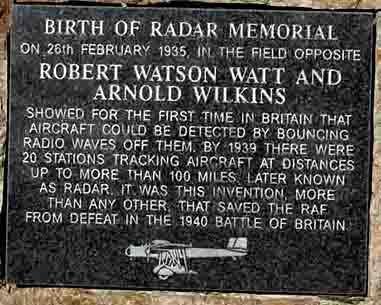The inscription reads
BIRTH OF RADAR MEMORIAL
on 26th February 1935 in the field opposite
ROBERT WATSON WATT AND
ARNOLD WILKINS
Showed for the first time in Britain that
aircraft could be detected by bouncing
radio waves off them. By 1939 there were
20 stations tracking aircraft at distances
up to more than 100 miles later known
as RADAR It was this invention more
than any other that saved the RAF
from defeat in the 1940 battle of Britain
Bob G4 GEE Brian G8GMU

Using a modern transceiver
( ICOM . IC 706) fed into
a simple wire dipole. Just as the original
antennas would have been for the historic
experiment
The contacts all on the 40 metre (7Mhz) Band were:-
DL6SX Nr Bayreuth
DK0HN nr Dortmund
GM0WED Orkneys
G0OIV Ashington
GI4DYE Strabane
PD0RYK Dokkum
MM3NVT Aberdeen
EI5DR Co Mayo
The original RADAR experiment was on the 49 metre band. |
|
The memorial was organised by the late Mr Rex Boyes, a former RAF engineer who used to live in Weedon. He obtained planning permission and funding for the memorial from Qinetiq. The memorial was opened in September 2001 by Nancy Wilkins, widow of Arnold Wilkins. Also attending were local MP Tim Boswell, chairman of Stowe-IX-Churches Parish Council Mr Keith Mason and the late Mr Denis Brodie on whose land the memorial stands. The Parish Council agreed to accept ownership of the memorial .
The site of the memorial is located off the A5 just South of Weedon on the Northampton Road. (NGR. SP650 557) 
World War 2 saw rapid and major advances to electronics in warfare.
The Defence Electronics History Society has a wealth of information
Link to DEHS Website
Link to RAF Cranwell Apprentices Association. Website
| 


